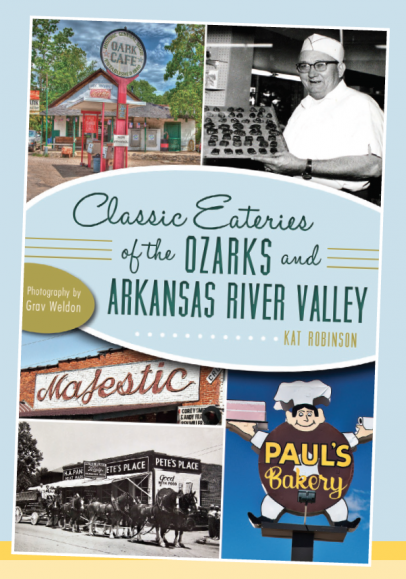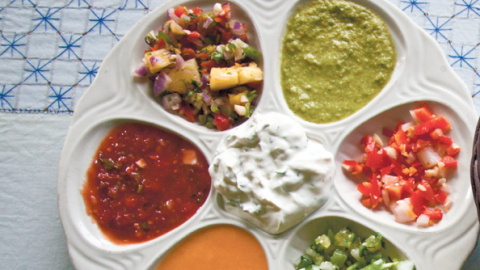Edible Culture: Eatery Excerpts
Editor’s note: Upon hearing that Kat Robinson, of Tie Die Travels, was releasing a new book highlighting Classic Eateries of the Ozarks and Arkansas River Valley, we jumped at the opportunity to showcase selections from her work. Local foods aren’t only what grow in the soil in Ozarkansas. Sure, we’re quite proud of those, but we also embrace the food culture of our region from the years and decades that led us up to where we are today. Here you will find a tasting of what we know to be a delightfully satisfying book.
Classic Eateries of the Ozarks and Arkansas River Valley is available from The History Press for $19.99.
Reprinted with permission.
__
Arkansas has a unique food culture, unheralded beyond our borders. Long considered to be a crossroads with little influence on the culinary world save the lone dish of cheese dip, The Natural State is the undiscovered country of culinary experiences.
Classic Eateries of the Ozarks and Arkansas River Valley touches on that very idea and pairs it with the origins of our native cuisine – transportation. Whether the press of immigrants from Italy and Sicily who, in one generation, came through Ellis Island to Sunnyside Plantation at Lake Village to form their own community at Tontitown; or the German and Swiss workers who traded the labor of building the Little Rock to Fort Smith Railroad in exchange for River Valley lands; or the press of a generation of drivers taking to America’s roads, spawning the birth of our diner and roadfood culture – the driving spread of our flavors and traditions comes directly from a connection with the railroads and highways that bisect this land of opportunity.
I hope with this book to shine a spotlight on our foodways – to preserve a segment of this history before it slips away. As it is, generations before us have already lost the stories of many of our restaurants. What remains are postcards, a few newspaper listings, and the rare photo on a back wall.
There are a lot of great food writers and bloggers in Arkansas chronicling every aspect from new fads to farm-to-table and family cooking. I consider it my job to capture the history. By focusing on the restaurants that have been around 20 years or longer, the ones with staying power, I’m hoping I’ve helped create a travelogue that will take hungry epicureans down great highways and satisfy even the most curious adventurer.
– Kat Robinson, December 2013
Susie Q’s Malt Shop // Rogers
Susie Q’s did not get its name from the Dale Hawkins song of 1957 (nor from the remake by the Rolling Stones in 1964 or the slow groove Creedence Clearwater Revival put on the hit in 1968). The name comes from a potato cutter. At least, that’s what Mildred Head is claimed to have said about the little stand alongside Second Street in Rogers.
The Head family built the structure as a fruit market, but when her cousin’s business failed, Mildred took over the place. The year was 1960. A friend of hers introduced her to a man from the Meadow Gold Ice Cream Company (which doesn’t exist anymore in the area), who helped her choose her equipment, got it ordered and even stuck around to see the business take off. Challenged with naming the new place, Mildred went with the name on the curly fry cutter. Thus, Susie Q’s Malt Shop was born.
Mildred ran the place until 1972, when she let her son, J.B., take over. She continued to work there until 1999, greeting customers and helping out. She passed away in 2002.
J.B. and his wife, Patti, kept it up, changing very little about the restaurant or its menu. In 2004, they sold the operation to cousin Patsy Head Simmons, a local Realtor who’d been hanging out at Susie Q’s practically since she was born.
Today, the neon still shines, and the restaurant thrives. And it’s become known for the Big Pig, one of the state’s few pork tenderloin sandwiches. The ice cream is cold, the shakes are a little frosty and that trip down nostalgia lane has to be taken in the warmer months, since the family shuts the place down during the winter.
The Grand Taverne // Eureka Springs
Is there such a thing as casual elegant? Upscale comfort? There must be a word somewhere for the sort of atmosphere you find at the Grand Taverne.
The restaurant is housed in the historic Grand Central Hotel on Main Street, Eureka Springs. The building dates back to 1880 as the place where passengers first arrived after disembarking from trains from the North. In 1987, the facility was renovated top to bottom, suites were created for guests upstairs, and a full-service spa and salon went in downstairs. The lobby, though, speaks of traditional Victorian charm; it’s packed end to end with period furniture.
The Grand Taverne spills out from its kitchen into this lobby. It’s named after the very first full-menu service restaurant to offer table service: Le Grande Taverne de Londres, opened in 1782 in Paris. The name was chosen to convey a sense of attention to detail on food quality and service.
Its chef, Dave Gilderson, was schooled at L’Ecole de Cuisine Français Sabine de Mirbeck in England. He apprenticed in the south of France before returning to the States and working his way up through a number of assignments, including Branson’s Big Cedar Lodge and his first stint as executive chef at the Candlestick Inn. Gilderson came to the Grand Central Hotel to open the Grand Taverne in 2003.
Chef Dave has become a community fixture, showing up at the farmers’ market often and appearing at just about any sort of fundraising experience. He’s put a board up on the sidewalk and writes something fanciful each night, and when you walk in, you can see what he did with the idea.
This is your fine dining experience, where you take your date when you’re very serious about that person. The place is lit mostly by candlelight, with perfect wait service and cloth, silver and crystal. And if you’re a connoisseur of fantastic food, you should consider the classic preparation of half duckling (blueberry citrus jus, dried cranberry wild rice) – a perfect duet of savory and sweet encompassing a marvelously prepared breast and leg of duck. And you have to get Chef Dave’s Montrachet goat cheese cheesecake if it’s offered – you just have to.
But here’s the interesting thing. If you’re lucky, there will be someone at the piano when you come in for dinner. And, as likely as not, that person could be none other than Jerry Yester of the Lovin’ Spoonful. He comes in often, regaling diners with renditions of the band’s greatest hits, including “Do You Believe In Magic?” and, one of my favorites, “Summer in the City.” And keep an ear open for one of his smart parodies.
Mary Maestri’s // Springdale
The oldest of the restaurants still serving the area is still with us, though it has moved from Tontitown to Springdale.
In 1904, there was a young Irish woman by the name of Mary Ritter who attended the Tontitown Grape Festival. There, she met Aldo Maestri. They fell in love, and soon, Mary moved in with the Maestri family, where she learned how to make pasta and sauces and all the good dishes Aldo loved.
In 1923, the grape harvest failed, and the young couple turned to selling dinners out of their home instead. Aldo made wine, Mary made the food, and word spread about the place way out in the country where you had to have reservations to come eat. Still, at 75 cents a person for all the pasta, chicken and bread you could eat, it was deemed well worth it.
The Maestri family didn’t have a telephone, but they did have a friend with a plane. He would drop reservations he took by phone over their place, and the restaurant prospered madly. Mary served up so much chicken she had to eventually sign on with a processor in town; before then, she caught and cleaned the birds from the farm herself. Mary and Aldo opened a larger restaurant in 1947 with their son, Edward, who was quite an innovator. He built machines that would roll and cut the pasta for Mary and figured out how to properly freeze meat sauce and spaghetti, and then he sold it to stores to sell to their customers.
Remember, this was before the TV dinner, at a time when the only frozen foods in the grocery stores there were strawberries. Aldo passed away in 1959, and in 1968, Ed took on the responsibilities of teaching the business to his 22-year-old son, Daniel, with the help of his mother. But in 1977, Ed died suddenly. Mary passed three years later. Daniel built a bigger home and restaurant that year, since the old one was structurally unsound. The 1980s and 1990s were tough times, but the restaurant managed to persevere.
In 2010, the Tontitown location was forced to close, but two years later, the eatery opened up in the former Front Porch Diner location in Springdale as Mary Maestri’s Italiano Grillroom and Aldo’s Wine and Coffee Bar. There, it is thriving. Today, Daniel’s three sons are heavily involved in the business.
A lot has been added to the menu, including steaks, sandwiches, seafood and spumoni. Mary Maestri’s no longer serves the bonein chicken beside the spaghetti. Instead, it’s chicken parmigiana, with a fried chicken breast served under the sauce over noodles. But it’s still that same great sauce that brought travelers to the Maestris’ door more than 85 years ago.
Barnett’s Dairyette // Siloam Springs
You can’t get much further west in Arkansas than Siloam Springs. Sharing a border with West Siloam Springs, Oklahoma, this burg hugging U.S. 412 stands as its own town, not just another bedroom community from the I-540/U.S. 71 metropolitan area.
It’s worth the ride over from Springdale through Tontitown just to have a burger and a shake at Barnett’s Dairyette. First opened in 1957 as a walkup dairy bar, the place has expanded to include a dining room. Eight burgers grace the menu, along with other favorites, such as footlong subs and tots. But what you really need to experience are the milkshakes: butterscotch, pineapple, peanut butter, pumpkin in the fall, strawberry pie in the summer and even a green mint chocolate chip version for St. Patrick’s Day.
Fred’s Hickory Inn // Bentonville
Many of the restaurants in this book were started by young folks who had a vision. Fred’s Hickory Inn started with a couple who were retiring at the end of other careers.
Fred and Lou Gaye retired to Bella Vista in 1969. Fred had been a petroleum engineer, and the couple had moved about quite a bit, spending time in 13 different countries. When it came time to settle, the couple decided to chase a lifelong dream. Fred and Lou purchased the Wildwood Camp, a couple of acres along Walton Boulevard (the local name for U.S. 71B). Now, there wasn’t much to the property, just a couple of abandoned buildings on top of a hill, but Fred saw value in the place.
As Sherry Mendenhall relates, “Fred told Lou he found this wonderful place to build a restaurant, and Lou thought he had lost his mind, ’cause the weeds had grown up almost taller than the building.” But the weeds were cut and the building renovated, and into the kitchen they both went. Fred smoked the meats, Lou created the side dishes, and thus was born Fred’s Hickory Inn in 1970.
“Fred used to drive up here in the mornings on his lawnmower,” Mendenhall says, “with his Chivas and soda in one hand. They had a dog named Chivas that would ride the lawnmower with him. So he would come up and put the meat on, and then they would come back in the early afternoon. Lou would make her meatballs and her spaghetti sauce, and then they would open at five o’clock.”
A lot of history has happened inside the cabin on the ridge. In Sam Walton’s book Made in America, it’s mentioned that the Walmart founder threw a surprise 60th birthday party for his wife there. Walton told Robin Leach on Lifestyles of the Rich and Famous that Fred’s Hickory Inn was his favorite restaurant. Bud Walton apparently agreed to donate the money for the basketball arena at the University of Arkansas over dinner there.
Mendenhall is the owner these days. She seated Sam Walton on her very first day on the job. She worked there for 21 years before buying the place in 2005. She’ll give you a list as long as your arm of famous folks who have come through the door: Jonathan Winters, Garth Brooks, Paula Abdul and Denver Pyle among them. The entryway is wallpapered with signed photographs of all the celebrities.
And yes, there’s a Clinton connection. Mendenhall says that before Bill Clinton officially announced he was running for president, he attended a retirement party there and quietly let the attendees know his intentions.
Fred’s specialty of smoked sirloin is still the top draw. If you’ve never had a smoked sirloin, it’s different. With hickory flavor all through the meat, it is sort of like a woodsmoke-flavored prime rib. I’ve never encountered that flavor elsewhere. Barbecue meats at Fred’s aren’t sauced; they’re dry rubbed with sauce on the side, if you really want it.
Lou still comes in. She’s 98 years old, and she still enjoys greeting the customers. And there are a lot of them. Any weekend evening, it’s hard to find a spot to park in the gravel-and-concrete lot behind the building. And forget about getting in when there’s a Walmart shareholders meeting going on. The restaurant was founded eight years after Sam Walton got going and a year after the chain was incorporated. The two grew up side by side there in Bentonville.
Bavarian Inn // Eureka Springs
Eureka Springs also boasts one of the few long-standing German restaurants in the state. The Bavarian Inn serves up German-Czech food in a chalet-style facility crisscrossed with heavy wooden beams, decorated with cuckoo clocks, and loaded with a menu of sausages, cabbage, and many things that are far better than the best sausage or cabbage.
The house specialty is half a roasted duck served in its own gravy, though you’re just as likely to get the Bavarian Plate, with smoked pork, bratwurst, sauerkraut and herbed potato pancakes.
All that is well and good and reason enough to stop in for a meal. But what you really want, no matter how stuffed you are from your meal anywhere else, is to drop in and have apple strudel and coffee. The strudel is served hot on a fine china plate and has a wispy, paper-thin, sugar-sprinkled crust that just embraces delectably spiced apples within. À la mode shouldn’t even be an option – it’s best with, of course.
KJ’s Caribe // Eureka Springs
Building on the love you share with someone can be one of the greatest experiences of your life. But what happens when one part of that equation is lost?
One answer can be found at KJ’s Caribe Restaurant y Cantina. Caribe (as everyone calls it) is out west of downtown on U.S. 62, a brightly decorated building, colored in every shade of the rainbow and oozing art. It’s a beautiful place to meet and chill. It’s also a remembrance.
The original restaurant was opened downtown by KJ Zumwalt and Clary Perez back in 1992. Clary was the cook; KJ worked the front of the house. They had a beautiful partnership. Clary’s Panamanian food brought them loyal and friendly customers both among the locals and among those who (like me) come up on a regular basis to enjoy the town.
Clary was born to a wealthy family in Panama. Her parents sent her to school in Cullman, Alabama, in 1961, and after graduation, she moved to New York City’s Greenwich Village. She found her way to the Arco Iris community in 1978 and moved to nearby Eureka Springs a short time later. KJ came to town in 1989 with, as she says, “a bad attitude and an overnight bag” to stay for three days, and she never left. They met, and it was beautiful. KJ was up front, warming customers with her effervescent attitude. Clary brought her native dishes out and won over the hearts of a community.
Sadly, some time back, KJ lost Clary. Rather than move on to another place or business, KJ did everything for the eatery they built together to succeed. She moved to the back of the house, cooking all the great food from Clary’s recipes and keeping her alive through that great food. She moved the restaurant in 2002, away from oppressively high downtown rents and into the building that she could eventually own outright. And every night, she cooks.
Four nights a week (Thursday through Sunday), KJ is in the kitchen with her sous chef and her dishwasher, turning out one dish after another. She’s like no other chef I’ve ever met. When I met her, she was wearing a little black dress, a black apron and pink cowboy boots. And she was vivacious as all hell.
Outside chili cook-offs and barbecue joints, I’ve never seen anyone else wear cowboy boots in a kitchen. But KJ dances. In her long kitchen, with its large windows and every color of the rainbow on the walls, she dances, whipping up guacamole, sautéing shrimp, and bringing together dishes that are causes for celebration.
Her signature item, the Center Street Salsa Platter, is seven concoctions for dipping, served up in an oyster dish. The sauces are a hot sweet mango pepper salsa, a red bell pepper pico, a green tomato pico, a pineapple pico, sour cream, a fresh tomato salsa, and a chutney-like tomatillo cilantro concoction.
KJ once pointed out to me the sauces’ deep tones on the white plate. “You see the green?” she asked and pointed at her eyes. “The lipstick salsa? It’s all about the love.”
I do see it. Clary’s recipes captured KJ’s green eyes and red lips, dollops of paint on a canvas of a beautiful partnership that continues over time and space, profound and absolute.
Passion. You know, you hear the word batted around on these TV shows, but KJ embodies it. Her food embodies it. Each flavor in the salsa platter punches through bright and clean and unique, especially on the flour and corn chips fried fresh each day. It shows in the remarkable turkey leg mole (you know you are a true friend when she grants you a jar of her splendid mole sauce). It shows in the huge mound of fresh guacamole, piled on spinach leaves in an oversized margarita glass and topped with tiny bits of tomatoes, spicy and rich and fresh.
And it shows up in what she does outside the restaurant. She’s intricately involved in this small hill-bound community. Everyone knows her. She’s out fundraising here and there, standing up for causes, and running pell-mell down Spring Street in those cowboy boots in the annual Waiters’ Race during the Fleur Delicious Festival. As I said, she dances, and the eatery she continues to nurture reinforces that through its flavors and the influences it continues to have on the cuisine of a community.
When I asked for recipes for this book, she responded in a flash, almost as quickly as I’d asked. Her contribution is a party-sized rendition of that marvelous guacamole.
>> Guacamole for a Big Party
The Red Barn // Fort Smith
After World War II, Fort Smith underwent a restaurant boom. Not only did the diner scene take off, but family restaurants also became very popular. The next generation saw another explosion, with family restaurants becoming more distinctive and more ethnic.
The city’s oldest steakhouse is The Red Barn. Located on the north side of town off Midland, not far from the Arkansas River, this is a restaurant within a century-old barn. In fact, this particular facility was used as a farm for Tennessee Walking Horses, one of which, it’s proudly shared, was purchased by Mr. J.C. Penney himself. It is an established place of horsery.
Of course, there’s more to it than that. Yes, the walls are still covered in farm implements and related décor, and the tables are located in stalls. But the floor is concrete and clean, and the food is marvelous. Eschewing new fads and trends, the menu has remained relatively the same since the 1946 opening.
The star of the show is the steak: New York strips, filet mignon, prime rib, T-bone, and a 22-ounce porterhouse that’s the restaurant’s specialty. Steaks come grilled or “chef charbroiled,” and they are known to be amazingly tender.
The house-made blue cheese dressing is renowned for its chunky texture. And the ham steak topped with a pineapple ring is right out of a 1960s road movie. But what I really find fascinating is the quail – as in, the panfried Boston Mountain quail. Here’s a locally sourced bird that’s always been brought in from close by, hand-battered and fried up in a cast-iron skillet. Get one, or get two; the birds come with cream gravy and a baked potato. I can’t think of another place that offers pan-fried quail, really.
What I hear the most about, though, are the biscuits. They come 20 to a pan, bite sized and buttery. Known as “Granny’s little biscuits,” they are highly addictive. Ask for yours when you order an appetizer, and sneak a couple into your doggie bag, which you’re probably going to need.
1886 Crescent Hotel // Eureka Springs
Even before Myrtie Mae Barrett was on the scene (and before she was born), there were tourists in Eureka Springs. They came for those healing waters (which, unlike those in Hot Springs, aren’t thermal), and they came because they wanted to be well. Think about this: If it’s the 19th century, you have enough money to go to a doctor, and you have enough money for the train to get there, chances are you are rich enough to want to stay at the best place you can.
Enter the Crescent Hotel. The Frisco Railroad and the Eureka Improvement Company got together in 1884 to put up what they planned to be the most luxurious hotel in America. Roughly two years later, on May 20, 1886, the famed inn opened with much fanfare, including a gala ball, a banquet dinner and famous folks from all over.
For 15 years, the hotel operated at the highest level of extravagance, sending footmen to fetch guests from the railroad, offering specialty services involving the springs – whatever it took. But that sort of service just wasn’t sustainable, and the property began to fail. In 1908, it became the Crescent College and Conservatory for Young Women, which ran its course and closed in 1924. It was reopened as a junior college in 1930, but that only lasted for four years, after which it was leased out as a summer hotel.
The whole shebang was turned into a hospital in 1937 by new owner Norman Baker, a millionaire-inventor turned radio personality turned doctor with – I kid you not – no medical training whatsoever. He claimed he’d discovered cures for many ailments, including cancer, which, for the most part, was just drinking the mineral water from the area’s springs.
Turns out “doctor” Baker had been run out of Iowa for doing something similar, and he was sent to jail in 1940 for mail fraud, for which he served four years. The hotel was purchased by four men in 1946, and it continued to operate until 1967, when a section of the fourth floor burned. There were efforts to fix it and keep it open, but eventually the Crescent was shuttered – that is, until 1997, when Marty and Elise Roenigk (the same couple who purchased War Eagle Mill) bought the old hotel and began a series of five stages of renovation. Today, the hotel is considered a top lodging option in the city, and it’s known as the Most Haunted Hotel in America by many sources.
Through the changes and in every incarnation of ownership, the hotel hosted a restaurant. With the 1997 purchase and subsequent reopening, the 1886 Crystal Ballroom was refounded, serving absolutely amazing, top-dollar dinners with traditional Victorian-style wait service. Recently, the evening service has been changed to the 1886 Steakhouse, with a more updated service style.
But what consistently draws guests both from this hotel and others is the famed Sunday brunch, combining breakfast specialties and omelets with hot dinner dishes, such as roast beef and pork loin, a selection of salads, marvelous desserts, a chocolate fountain and champagne – sometimes in the form of mimosas.
Even if you have concerns about staying in a haunted hotel, don’t let it keep you from coming down for brunch on Sunday and enjoying this particular dining experience. You’ll meet folks from all over the world who have come to Eureka Springs for everything it has to offer.
The good folks at the 1886 Crescent Hotel have allowed me to share this historic recipe, at right.
>> Historic Muffins
Benson’s Grill // Fort Smith
If you ask around town about diners, chances are you’ll be referred to what’s known as Fort Smith’s king of late-night dining. Benson’s Grill was started in 1992 by Benson “Ben” Canoy. He named the place more after his grandfather (his namesake) than himself. It quickly became the hottest twenty-fourhour ticket in town.
Benson’s Grill is about comfort food. It’s known for sweet potato pancakes served with a lump of margarine and a hot dispenser of syrup, for greasy patty melts and burgers, for the BELT (a BLT with egg) and the GOT’cha (Gravy On Top of eggs, biscuits, hash browns and sausage) and for the mysterious Chump (never on the menu and never revealed to those who do not choose to dine on the divine delicacy).
Canoy sold the place five years after opening to Don Tate, who still runs it today. Canoy ended up starting Lucy’s Diner in 2010, naming that establishment after his mom. He passed away in February 2013.
Still, at Benson’s there’s something happening at all hours. If it’s after midnight and you spot a sign on the table when you walk in, leave it alone – someone’s gone out to have a cigarette. If it’s dawn and the jukebox is humming, wait until Stevie Ray Vaughan is done before you drop in another quarter. And whenever you go, listen for the sweet drawl of one of the even sweeter waitresses who are full of conversation, advice, and suggestions on your perfect comfort-food breakfast.
Monte Ne Inn Chicken Restaurant // Springdale
There’s one more famed fried chicken place to talk about that’s not too far out from Springdale: the Monte Ne Inn Chicken Restaurant. It’s the only restaurant in the vicinity of the ruins of Monte Ne and the only steady restaurant on the way out to the Horseshoe Bend Recreational Area run by the Army Corps of Engineers on Beaver Lake (though there is a small Inside seasonal pizza joint along the way). The menu never hits the table at the eatery because, if you go, you’re going to get the exact same thing everyone else is going to get: a filling family-style dinner of fried chicken and all the fixings, brought to your table and refilled until you are stuffed. Just don’t forget to make reservations.
Open since 1975, the restaurant has survived with a simple business model. Six nights a week (and Sunday afternoon), guests show up at their appointed time. You’re given a seat and a bean crock – hot bean soup. A table laden with delicious home cooking follows: bowls of fried chicken, string beans, corn, mashed potatoes, gravy and coleslaw, small containers of apple butter and creamery butter, and a fresh soft loaf of bread. It’s a feast, and you can have as much as you want. The catch is that you put your own food on your own plate. The family-style service means it doesn’t matter if you have two or 20 at your table; that’s just how the meal is served. I have seen different couples seated together as strangers who walked away as friends when the meal was over. It’s marvelous.
After I looked back through all the Ozark greats in fried chicken, I noticed one other thing. Every one of them offers soft rolls and the butter and honey to go along with them. I don’t think that’s an accident. Honey and bread have been a tradition here as long as bread has been leavened in these parts. Arkansas is blessed with good bees and good honey and an eye for getting that honey to the table. But that’s a story for another time.









